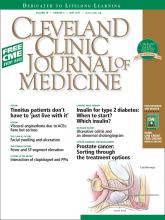Table of Contents
From the Editor
- Recognizing the unusual: The diagnostic epiphany
We have all experienced the sudden recognition of an unexpected diagnosis, such as the case of visceral angioedema due to angiotensin-converting enzyme therapy reported by Korniyenko et al in this issue of the Journal.
The Clinical Picture
- A 46-year-old man with fever, ST-segment elevation
ST-segment elevation commonly represents acute myocardial infarction, but it is also associated with other conditions.
- Facial swelling and ulceration with nasal destruction
A 12-year-old boy presents with painless swelling and ulceration on and around his nose. What is the diagnosis?
Review
- Visceral angioedema due to angiotensin-converting enzyme inhibitor therapy
If a middle-aged woman taking an angiotensin-converting enzyme inhibitor presents with abdominal pain and emesis, the differential diagnosis should include this uncommon but serious complication.
Im Board Review
- Ulcerative colitis and an abnormal cholangiogram
The patient, who has had ulcerative colitis for more than 30 years, now has mild, intermittent pain in his right upper quadrant. What is the diagnosis?
Review
- Tinnitus: Patients do not have to ‘just live with it’
Physicians should actively listen to the patient and provide hope and encouragement, balanced with realistic expectations. Specialists can help.
Patient Information
Cancer Diagnosis and Management
- A practical guide to prostate cancer diagnosis and management
Screening, diagnosis, and management of prostate cancer can be complicated, with no clear consensus about key issues. Our approach refl ects the guidelines from the American Urological Association.
Current Drug Therapy
- Insulin treatment for type 2 diabetes: When to start, which to use
Many patients with type 2 diabetes eventually need insulin. This review addresses practical approaches.
Departments
- Coadministration of clopidogrel and proton pump inhibitors (January 2011)
A reader comments on the interaction between clopidogrel (Plavix) and proton pump inhibitors (January 2011).




